Sandisk Ultra 400gb Microsd Card Reviews for Phone
Almost all content capture devices apply memory cards (flash-based removable media) for storage. Hand-held consoles and many other computing systems (PCs too every bit smartphones) besides employ them for augmenting the available storage capacity. There are different varieties of memory cards catering to various performance levels. CompactFlash (CF) became popular in the belatedly 90s. However, has now been overtaken by Secure Digital (SD) cards. In our series of retentiveness card reviews, we recently looked at the PNY Elite microSDXC UHS-I 512GB, where nosotros had mentioned that the SanDisk Ultra 400GB seemed to be priced much lower on a per-GB basis. We now have the functioning numbers for the SanDisk card to enable united states of america to understand the high-capacity microSDXC card market better.
Introduction
SD (Secure Digital) cards were introduced in 1999, every bit an update to the existing MultiMediaCards (MMCs). It gained traction fifty-fifty in areas where CompactFlash had been preferred, thanks to its small size. Its popularity is evident by the fact that it has spawned 2 follow-ups in the aforementioned form factor - starting with the SDSC in 1999 for capacities betwixt 1MB and 2GB, we got SD High Chapters (SDHC) in 2006 (upwardly to 32GB) and SD eXtended Chapters (SDXC) in 2009 (up to 2TB). The cards also come in various sizes - standard, mini, and micro. Currently, the standard and micro sizes are more than popular in the market. SD'southward popularity and affordability has meant that virtually all consumer cameras come up with a SD card slot.
Recently, we take seen a number of high-capacity microSDXC cards getting introduced. Starting with the 400GB SanDisk Ultra microSDXC UHS-I card ($94 at $0.23/GB) introduced in Baronial 2017, we now accept the Integral 512GB and the PNY Aristocracy 512GB in the market place as well. At Computex 2018, we too saw plans from ADATA and Team Grouping to sell 512GB microSDXC cards. With the industry migrating to 3D NAND, the capacity per die has seen significant increment, allowing for microSDXC cards to reach these capacities. The SanDisk Ultra microSDXC 400GB is a UHS-I menu with a U1 (UHS Speed Class) / A1 (Application Performance) rating. Compared to the PNY Elite 512GB we reviewed earlier, the master deviation is in the A1 rating that guarantees a minimum performance level in non-content capture scenarios (such every bit usage in smartphones). The A1 rating suggests that the card tin sustain ten MBps of sequential accesses, 1500 Read IOPS, and 500 Write IOPS.
SanDisk supplied u.s.a. with a retail sample of their Ultra microSDXC 400GB card to put through our comprehensive memory card evaluation routine. Prior to taking a look at the performance numbers, we take a look at the testbed setup and evaluation methodology.
Testbed Setup and Testing Methodology
Evaluation of retentiveness cards is done on Windows with the testbed outlined in the tabular array below. The USB iii.1 Type-C port enabled by the Intel Alpine Ridge controller that connects to the Z170 PCH via a PCIe iii.0 x4 link is used for benchmarking purposes on the testbed side. uSD cards utilize the Lexar Professional Workflow SR2 SDHC / SDXC UHS-II USB 3.0 Reader along with the microSD to SD adapter supplied by the menu vendor. The reader was placed in the Lexar Professional Workflow HR2 hub and uplinked through its USB 3.0 port with the help of a USB three.0 Type-A female person to Type-C male cable.
| AnandTech DAS Testbed Configuration | |
| Motherboard | GIGABYTE Z170X-UD5 TH ATX |
| CPU | Intel Core i5-6600K |
| Memory | Chiliad.Skill Ripjaws four F4-2133C15-8GRR 32 GB ( 4x 8GB) DDR4-2133 @ xv-15-xv-35 |
| Os Drive | Samsung SM951 MZVPV256 NVMe 256 GB |
| SATA Devices | Corsair Neutron XT SSD 480 GB Intel SSD 730 Series 480 GB |
| Improver Carte | None |
| Chassis | Cooler Principal HAF XB EVO |
| PSU | Libation Primary V750 750 West |
| OS | Windows 10 Pro x64 |
| Cheers to Cooler Main, GIGABYTE, G.Skill and Intel for the build components | |
The full details of the reasoning behind choosing the higher up build components can be found here.
Sequential Accesses
SanDisk claims speeds of upwards to 100 MBps. Nevertheless, existent-world speeds are bound to be lower. In fact, writes can sometimes be much slower. For most applications, that really doesn't thing every bit long as the carte du jour is capable of sustaining the maximum possible rate at which the camera it is used in dumps data. We use fio workloads to emulate typical camera recording conditions. We run the workload on a fresh card, and also later on simulating extended usage. Instantaneous bandwidth numbers are graphed. This gives an idea of performance consistency (whether there is appreciable degradation in operation every bit the corporeality of pre-existing data increases and / or the carte is subject to wear and tear in terms of corporeality and type of NAND writes). Further justification and details of the testing parameters are available here.
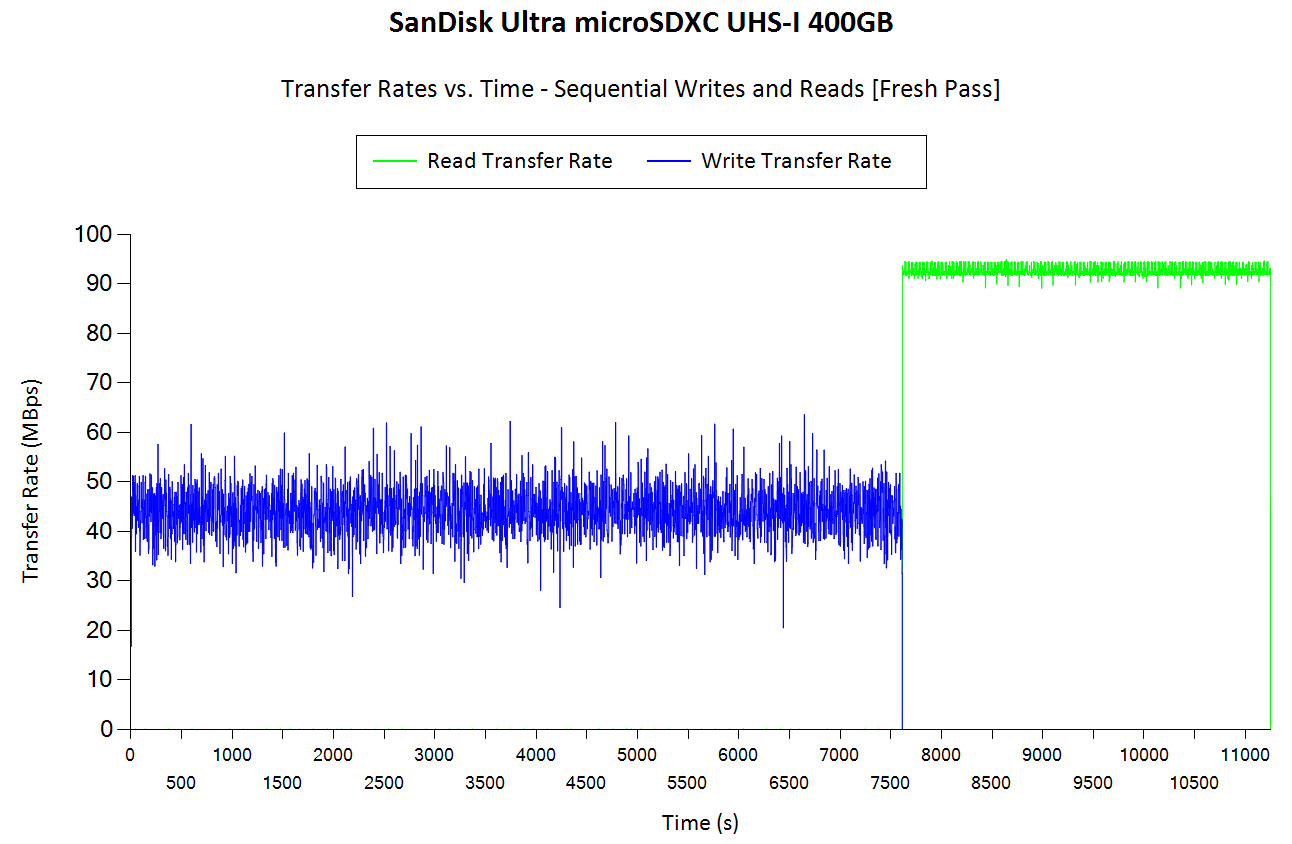
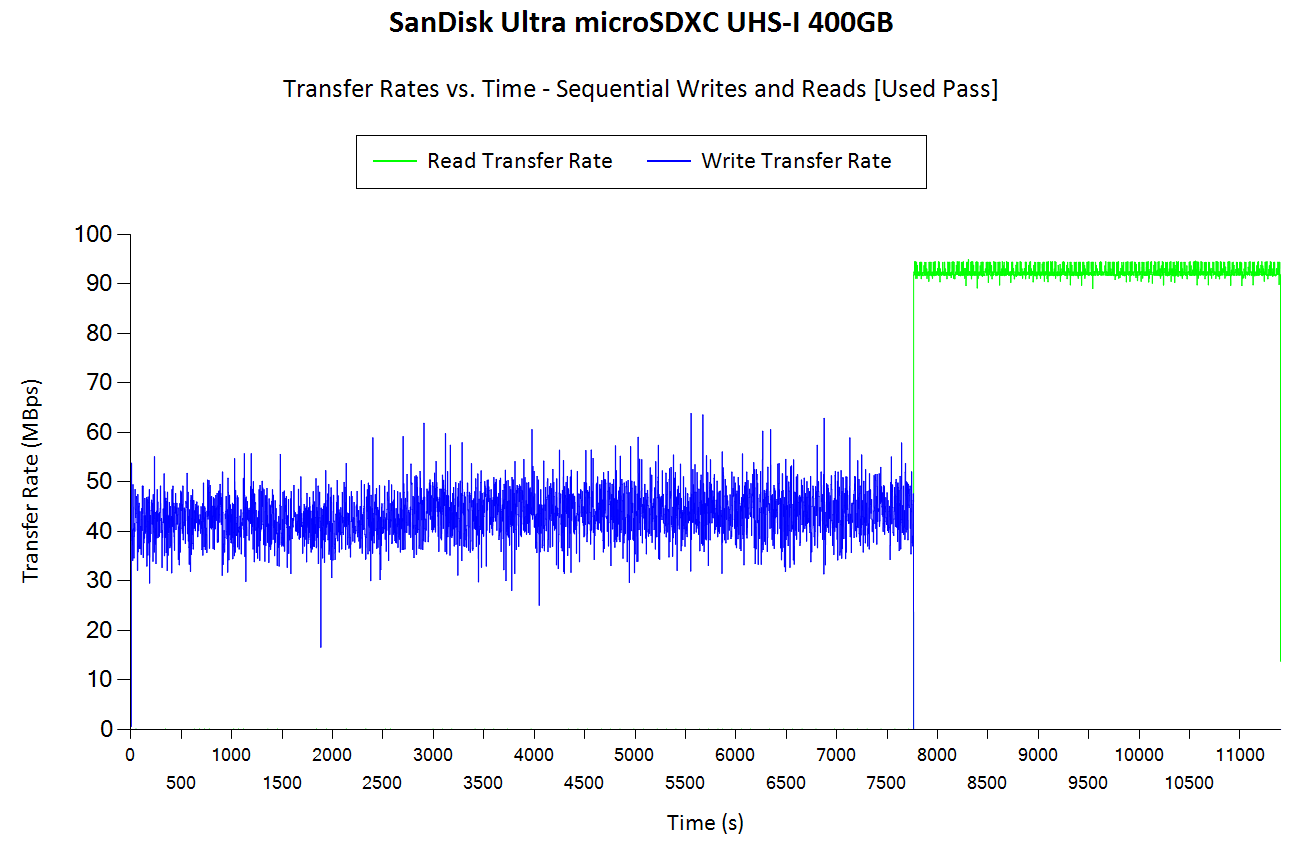
The read functioning is shut to the claimed numbers and similar to that of the PNY Aristocracy 512GB card. The writes are much better - averaging effectually xl - l MBps in both the fresh and the used passes. This compares much favorably to the PNY Elite'southward 22 MBps. There is a slight dip below 20 MBps in the used pass, simply, that performance loss is typical of near all memory cards which haven't been subject to functioning restoration by formatting after extended usage.
AnandTech DAS Suite - Performance Consistency
The AnandTech DAS Suite involves transferring large amounts of photos and videos to and from the storage device using robocopy. This is followed by selected workloads from PCMark 8's storage benchmark in order to evaluate scenarios such as importing media files directly into multimedia editing programs such as Adobe Photoshop. Details of these tests from the perspective of memory cards are available here.
In this subsection, we bargain with operation consistency while processing the robocopy segment. The graph beneath shows the read and write transfer rates to the retention carte while the robocopy processes took identify in the background. The data for writing to the card resides in a RAM bulldoze in the testbed. The first three sets of writes and reads stand for to the photos suite. A minor gap (for the transfer of the videos suite from the primary drive to the RAM drive) is followed by 3 sets for the next information set. Some other small RAM-drive transfer gap is followed by iii sets for the Blu-ray folder. The corresponding graphs for similar cards that we have evaluated before is available via the drop-downwards selection.
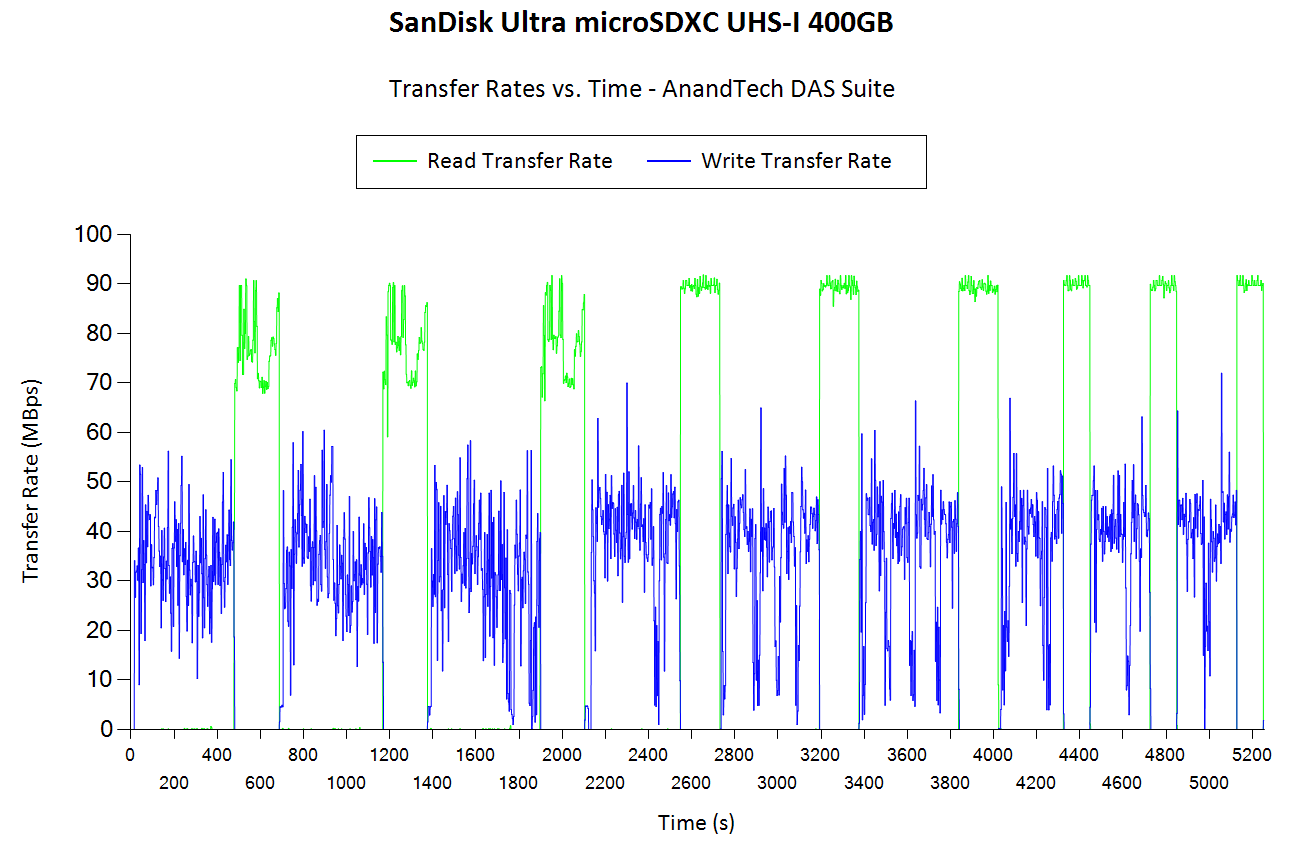
Typical of near all memory cards, we see small files bringing down the write rates. The key takeaway hither is that there is no consistency issue between ii passes for the same data. That said, writing large files tends to testify varying performance levels between x and 55 MBps (skewed towards the larger value) unlike the PNY Elite which comes in at twenty MBps balanced all through.
AnandTech DAS Suite - Bandwidth
The average transfer rates for each workload from the previous department is graphed below. Readers can go a quantitative number to compare the SanDisk Ultra microSDXC UHS-I 400GB uSD menu against the ones that nosotros have evaluated before.

We also look at the PCMark 8 storage bench numbers in the graphs beneath. This gives an idea of how the cards would behave in a relative way when subject to application workloads. Note that the bandwidth number reported in the results don't involve idle time pinch. Results might appear depression, but that is role of the workload characteristic. Note that the same testbed is being used for all memory cards. Therefore, comparing the numbers for each trace should be possible beyond different cards.

The performance numbers here reflect the speed class rating of the carte du jour. The SanDisk Ultra is non the fastest UHS-I menu - the SanDisk Farthermost trumps information technology, admitting at a lower capacity point. Like the PNY Aristocracy, the SanDisk Ultra is not a speed play. Rather, information technology is a capacity play, which is not reflected well in this evaluation segment.
Performance Restoration
The traditional memory card use-case is to delete the files on it subsequently the import process is completed. Some prefer to format the card either using the PC, or, through the options available in the photographic camera bill of fare. The get-go option is non a great 1, given that wink-based storage devices run into bandwidth issues if garbage collection (processes such as TRIM) is not run regularly. Different retentiveness cards take different ways to bring them to a fresh state.Based on our experience, uSD cards have to be formatted using the SD Formatter tool from the SD Association (subsequently all the partitions are removed using the 'make clean' command in diskpart).
In order to test out the effectiveness of the operation restoration process, we run the default sequential workloads in CrystalDiskMark before and subsequently the formatting. Note that this is at the end of all our benchmark runs, and the carte du jour is in a used state at the showtime of the procedure. The corresponding screenshots for similar cards that we have evaluated before is bachelor via the drop-downwards selection.
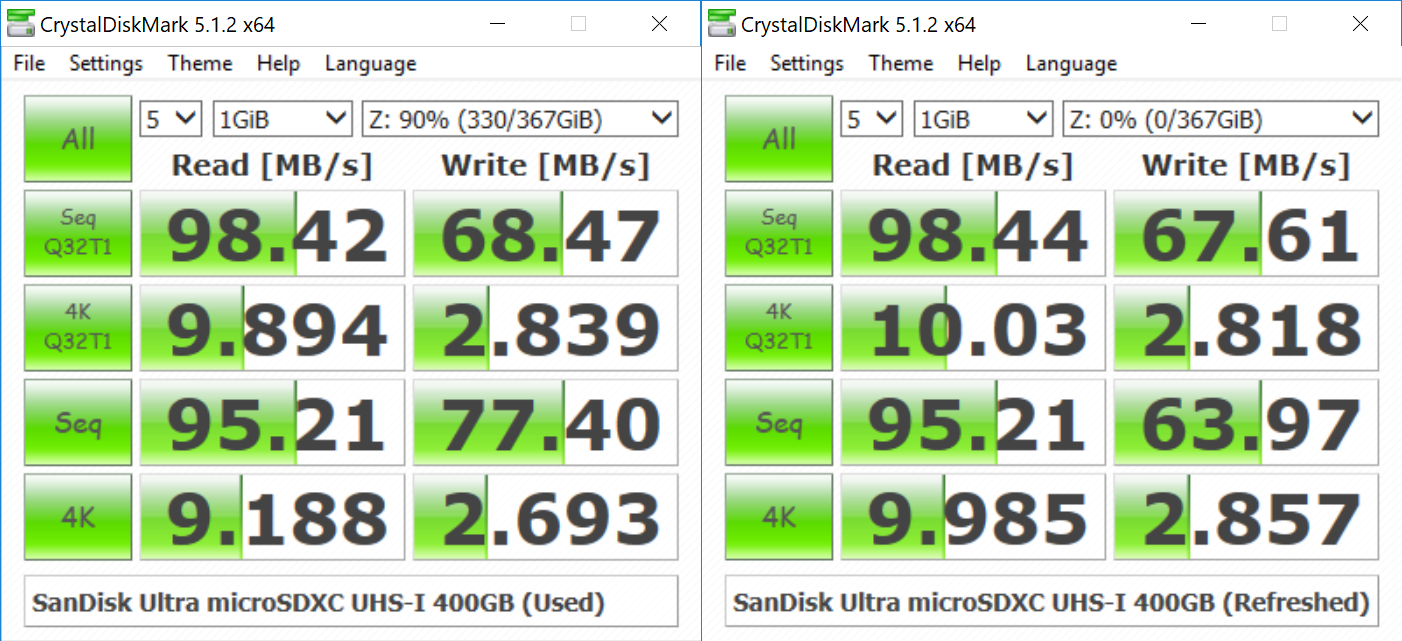
We do see a drop in the write rate later on operation restoration, with numbers similar to what we see in the sustained write workload. The performance is yet ameliorate than the requirements of the claimed speed rating.
Concluding Remarks
The SanDisk Ultra microSDXC UHS-I 400GB bill of fare successfully completed our intensive benchmarking routines. It showed improve performance numbers than the PNY Elite - the only other loftier-capacity microSDXC menu that we have reviewed. However, in terms of raw benchmark numbers, it emerged equally an average performer in the UHS-I course of cards in our functioning database.
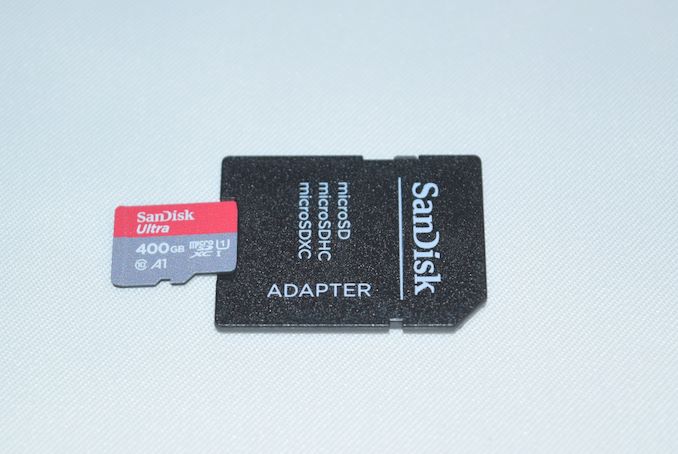
In improver to raw performance and consistency, pricing is likewise an of import aspect. This is particularly important in the coincidental user and semi-professional markets, where the value for coin metric often trumps criterion numbers. The table below presents the relevant data for the SanDisk Ultra microSDXC UHS-I 400GB uSD card and other similar ones that we take evaluated before. The cards are ordered by the $/GB metric.
| uSD Cards - Pricing | ||||
| Card | Model Number | Chapters (GB) | Street Price (USD) | Price per GB (USD/GB) |
| SanDisk Ultra microSDXC UHS-I 400GB | SDSQUAR-400G-GN6MA | 400 | 94 | 0.23 |
| SanDisk Farthermost microSDXC UHS I 128GB | SDSQXAF-128G-GN6MA | 128 | 39 | 0.30 |
| PNY Aristocracy microSDXC UHS I 512GB | P-SDU512U190EL-GE | 512 | 280 | 0.55 |
| ADATA Premier ONE microSDXC UHS II 256GB | AUSDX256GUII3CL10-C | 256 | 224 | 0.88 |
| FreeTail EVOKE Pro microSDXC UHS 2 64GB | FTUD064A10 | 64 | 56 | 0.88 |
| Lexar 1800x 128GB | LSDMI128CRBNA1800R | 128 | 190 | 1.48 |
| SanDisk Extreme PRO microSDXC UHS II 128GB | SDSQXPJ-128G-GN6M3 | 128 | 200 | 1.56 |
The SanDisk Ultra card is not meant to be a benchmarks winner - rather, SanDisk wants to focus on the market segment which requires high capacity with minimum guaranteed operation numbers for usage in application scenarios (such every bit loading games in smartphones or even portable game consoles). The Ultra is an attractive carte du jour for content creators in the field who want to tape a lot of content between imports to a bigger PC or network-continued mass storage device. Information technology also targets users who tin can't afford the downtime / recording pause that is inevitable during card swaps (when using smaller capacity cards). The PNY Elite (that targets a similar market segment) does edge it out with a slightly higher capacity (512GB vs. 400GB).
Due to its UHS-I rating, the SanDisk Ultra doesn't sport plenty performance to consistently record videos with very loftier bitrates. Nonetheless, information technology should be more than enough for content in the 150 Mbps range. With its A1 rating, information technology is also a good pick for expanding the storage capacity of smartphones and portable game consoles such equally the Nintendo Switch.
Source: https://www.anandtech.com/show/13717/sandisk-ultra-microsdxc-uhsi-400gb-memory-card-capsule-review
0 Response to "Sandisk Ultra 400gb Microsd Card Reviews for Phone"
Post a Comment